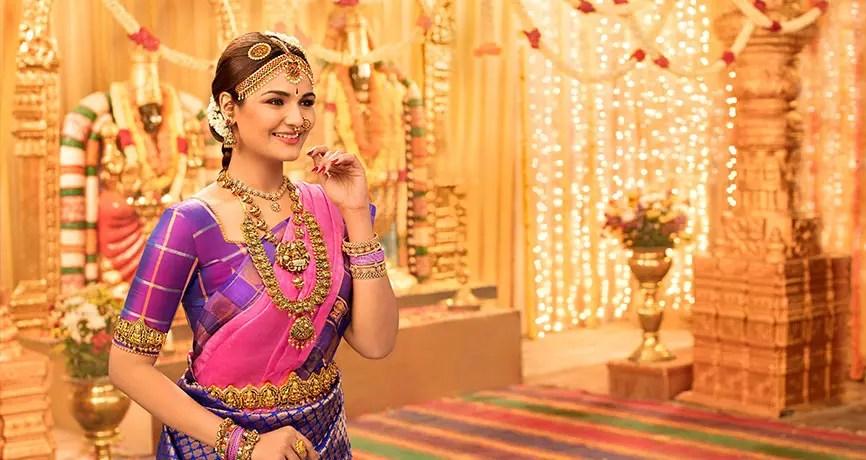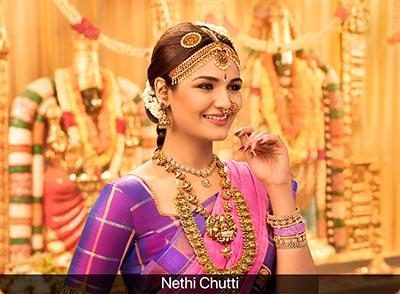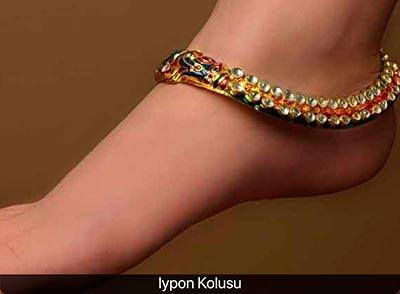South Indian jewellery trends – Tamil Bride


Tamil Nadu is the southernmost state of India, located at the tip of the Indian Peninsula. Famous for its classical dance, music, temples, architecture, food, movies, hill stations and pilgrim centres, a trip to Tamil Nadu is an item worthy of your bucket list. It’s a land steeped in ancient Dravidian culture, and its language, Tamil, is one of the oldest classical languages still widely spoken in the world.
When one hears the words South India – Madras, idli, vada, sambar and Bharatanatyam are the images that jump to the mind. And when one pictures a South Indian bride – the Tamil bride in her rich Kanjeevaram sari, wearing heavy gold jewellery , plaited hair bedecked with flowers, is what one imagines.
As the song ‘Sita Kalyanam Vaibhogame’ resounds through the air, the Tamil bride in her silk kanjeevaram saree looks resplendent like goddess Sita at her wedding with Lord Rama. The Iyer and Iyengar Brahmins wear a nine-yard ‘Madisar’ in bright hues with thick gold borders. The bridal jewellery is mainly temple jewellery with intricately carved huge pendants with figures of Gods and Goddesses, mainly Krishna, Karthikeya, Ganesha and Gaja Lakshmi. Crocodiles, swans, parrots, peacocks, serpents, elephants, lotus, “Gopurams”, mangoes or mythical creatures such as Yali, Makara feature extensively in temple style jewellery. Jewellery is made of antique gold or yellow gold with kemp stones or rubies and other precious stones. These are mainly crafted in the village of Vadasery in Tamil Nadu by master craftsmen in their ‘Pattarais’ (workshops).


Choker necklace called ‘Addigai’ is made of white stones or with leaf-like motifs and are called ‘Kodi Addigai’. The necklaces called ‘Harams’ or ‘Malais’ are usually ‘Maanga Malai’ which is made of mango shaped motifs, ‘Kodi Malai’ made of leaf motifs, ‘Kaasu Malai’ made of gold coins. The kaasu malai sometimes contains motifs of goddess Lakshmi engraved on it and is called ‘Lakshmi Malai’. ‘Pulinaga Malai’ is made of Pulinagam or motifs in the shape of tiger claws. ‘Sangili’ is a long gold chain worn with huge ornate pendants . ‘Malligai Arumbu Malai’ is a choker or mid-length chain with motifs of jasmine buds. ‘Chandra Harams’ with multiple layers of gold chains made of round gold beads with or without bejewelled pendants is an eternal favourite. ‘Makara Kanti Harams’ with huge pendants studded with precious gems and rubies, ‘Contrakaram’, ‘Chavadi’ are some other choices. ‘Muthu Malai’ and ‘Linga Padakka Muthu Malai’ are made of strings of pearl. The latter ends in a large gold pendant consisting of a Shivling encrusted with emerald and encompassed with peacock and lotus designs.


The waist belt called ‘Oddiyanam’ which keeps the sari in place is made of gold or silver and often has elaborate figures of Gods and is beautifully decorated with pearls, diamonds, rubies and precious stones. Some designs may have layers of delicate chains attached to the belt to further accentuate the waist and hip.

Although gold is much loved and widely preferred, the new bridal trends show a growing affinity towards Kundan and Polki jewellery made of uncut diamonds with an antique finish.
You can find all this and much more at the “Muhurat” floor in Kalyan Jewellers. An entire floor dedicated to bridal jewellery from different regions of India .